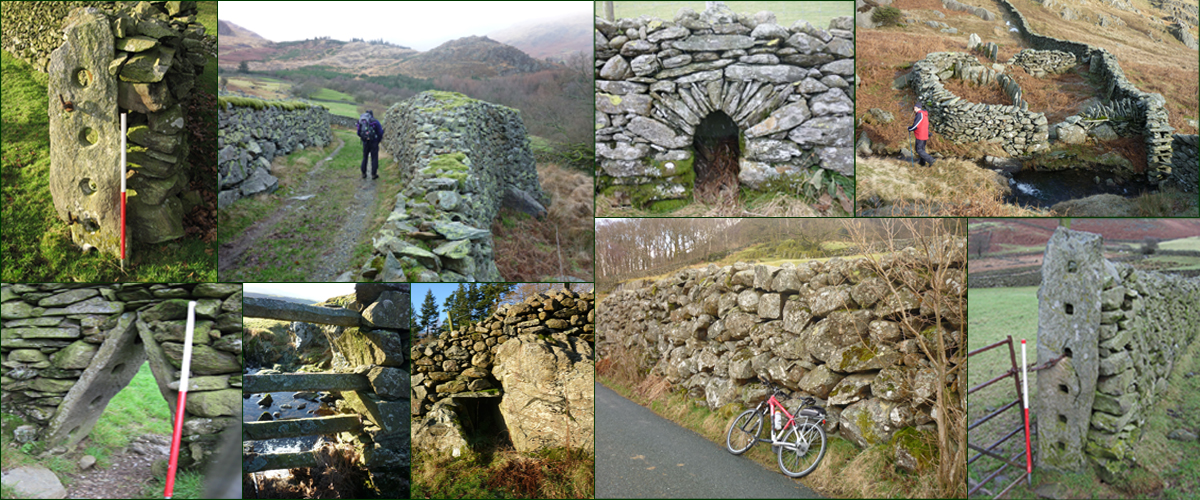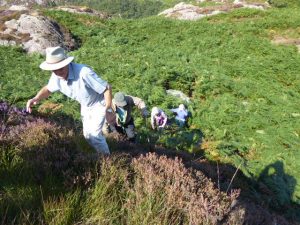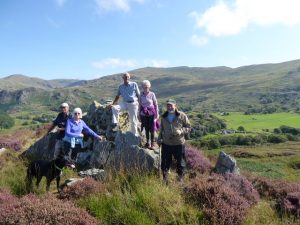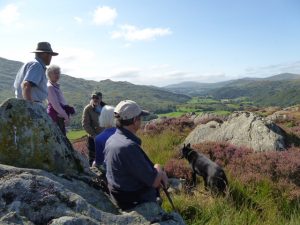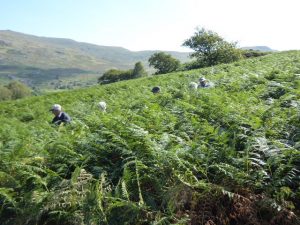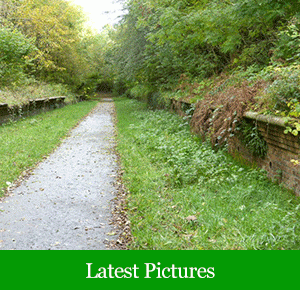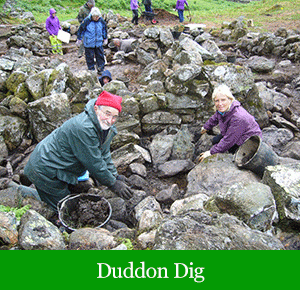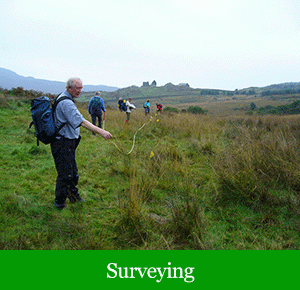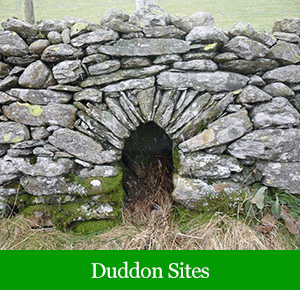All the walks have been graded as 'moderate' or 'easy' in difficulty. This means that we will be walking over ground that may be may be rough, stony or boggy. A reasonable fitness level is therefore needed on uneven, rising/falling ground. Participants need to take responsibility for their own comfort and safety by wearing suitable footwear as well as warm and waterproof clothing. Participants also need to bring a packed lunch and drink.
If you want to lead a walk or have an idea for a walk, please get in touch through the chair -chair@duddonhistory.org.uk
Please note some walks will incur addition costs eg entrance fees or fares.
Are you planning on joining a walk?
Please contact the leader with any specific queries.
It’s helpful if walk leaders have some idea of who is intending on coming on a walk. It makes it possible to arrange lifts/car sharing and makes cancelling easier in the event of very bad weather. It prevents hanging about waiting at picking up points. It is especially important if you are going directly to the start of the walk. Please contact walk leader the night before or at least half an hour before the meeting time at Broughton.
Where the leaders are going to the walk start directly, a Broughton contact will be given to co-ordinate travel.
11 Sunday 7th April 2024
Swinside Stone Circle through Black Beck Valley Gareth Broome and Fiona Oliver
broome13@gmail.com 07704 982499 01229 716926
Thwaites Mill, Broadgate House, Sunkenkirk, Fenwick, Windy Slack, road back. Mostly on minor roads/farm tracks, easy inclines
Easy to moderate. 5.5 miles/9km. Height gain 900’/270m. 4hrs total
Broughton Square 10.00; Old road near Broadgate 10:30 - beyond entrance to Beck Bank Farm SD 18455 86725
Dogs welcome but only on a lead
If you are interested, please contact the leader directly and register your interest.
NOTE: REPORTS OF PREVIOUS WALKS CAN BE SEEN BELOW THIS YEAR'S PROGRAMME
12 Wednesday 17th April 2024
13 Sunday 5th May 2024
14 Wednesday 15th May 2024
15 Sunday 2nd June 2024
16 Wednesday 19th June 2024
17 Sunday 7th July 2024
18 Wednesday 17th July 2024
19 Sunday 4th August 2024
20 Wednesday 21st August 2024
21 Sunday 1st September 2024
Walk Reports
Walks 2023-2024
9 Sunday, 3rd March 2024 Bridges and Water Yeats - Martin Salter-Smith
No report sent
8 Wednesday, 28th February 2024 Cartmel Fell Church from Gummers How car park - Lindsay Harrison
Cancelled
7 Sunday, 11th February 2024 Great Stickle - Gail Batten
With the weather not looking to bad 14 of us met up at Whineray Ground. We set up the path, a well-made footpath more likely the main track /road going to
Broughton Mills. I pointed out the stone-built building that was used in the filming “The one that got away”.
As we got to the ring cairn at top of first hill, everyone could then see what we would be looking at, these ring cairns have been dated as bronze age. Then we looked at the various areas of Peat, which was used for fuel by the nearby farms and houses. Maybe that’s is what the track was built for. Next, we looked at a
potash pit these were used for burning bracken to make into a soap for washing wool.
The walk took us past various ring cains before we dropped down to look at the retting ponds at Old Hutton and discuss the retting of plants hemp or flax. This was the rotting down of the plants to make into linen or maybe rope.
We next stopped for lunch under Great Stickle before heading off to look at the cist cairns under Stickle Pike. From here we headed up to Tarn Hill to head back down the same way back to the cars, finding more cairns on the way back
The walk was 3.5 hrs and about 4 miles and stayed dry.
6 Wednesday, 17th January 2024 The Hospice, Hampsfell and Cartmel Priory Church - Bob Bell
Cancelled
7 Sunday, 7th January 2024 The Story of the Eccleriggs Estate - Stan Aspinall
No report sent
2. Wednesday 15th November Bridges
Cancelled
1. Sunday 1 October 2023 Historic Ulverston Walking Quiz -Linda Marshall
No report sent
Walks 2022-2023
16 Wednesday, 20th September 2023, Blawith Beacon Trek - Lindsay Harrison
15 Sunday, 3rd September 2023, Birkrigg - Linda Marshall
14 Wednesday, 16th August 2023, St. Bees station to Whitehaven railway station - Bob Bell
The walk was from St Bees railway station to Whitehaven railway station. The distance was about 7 miles. There were 4 participants on the walk including myself.
Our first stop was a small memorial garden dedicated to St Bega who escaped from Ireland to avoid an arranged marriage. She lived the life of a hermit and gave her name to St Bees.
At St Bees beach we visited a memorial to Alfred Wainright who in the 1970’s “invented” the Coast to Coast walk to Robin Hood’s Bay in Yorkshire. At the same place there was a memorial to the SS Izaro – a small Spanish coaster which broke down and was wrecked near St Bees in 1907. Luckily no lives were
lost – but it does explain why lighthouses such as that on St Bees Head were needed to guide seafarers at a time before ships had radio.
We had a picnic lunch on St Bees Head close to the lighthouse. The sun was out and the sea was shimmering. Visibility was excellent – both towards the Isle of Man where Snaefell and Point of Ayre were in clear view. Similarly the Dumfries & Galloway coast was clearly visible whilst beneath us a local boat could be seen checking his lobster pots.
Thereafter we visited Birkham Quarry where sandstone is removed in the early spring over 2 -3 months each year for use in renewing worn-out sandstone on buildings such as Barrow Town Hall, Liverpool Anglican Cathedral and even Furness Abbey.
Finally we visited the remains of the various pit heads on our walk into Whitehaven. The most famous pit is of course Haig Pit which operated from 1916 to 1986. There is a memorial outside which records the names of those who died in an explosion in 1922 including the bodies of 13 men whose bodies
were never recovered and who remain entombed within the mine.
More poignantly I read out the details of an explosion at William Pit (on Whitehaven’s north shore) in 1947 when 104 men & boys were killed. There were only 10 survivors. That pit opened in 1805 and finally closed in 1955. That disaster had taken place on 15 August 1947 – exactly 76 years and one day
before the date of our walk. We could all visualize the incredible human tragedy which occurred on that day throughout the whole Cumberland coalfield as rescue parties from Northumberland, Durham & Lancashire came in to give what assistance they could.
Bob Bell – walk leader
13 Sunday, 6th August 2023, Mitredale to Eskdale - Mervyn Cooper
Setting off from Eskdale Green with five walkers and two dogs, we walked up Miterdale and then climbed up onto Burnmoor to visit the stone circles at White Moss and Brats Hill. Before a descent to Blea Tarn, we passed the remains of a lengthy wall built by one of the Pharoahs..!! ( Crispin Pharoah 1782).
Further site visits to Ban Garth open-pit iron ore mine and a peat hut, before a ‘surprise’ return via the Japanese Garden in Giggle Alley Forest.
12 Wednesday, 19 July 2023 Duddon Mosses National Nature Reserve - Jim Turner
Meeting at Simon Lock Bridge, fourteen DVLHG members enjoyed a very informative walk and talk around the lowland raised bog at Duddon Mosses. Jim Turner explained how the peat litter had been commercially extracted in the 19th century using barges from Galloper Pool to Simon Lock Bridge to export the peat litter used for animal bedding amongst other uses.
Jim also explained why Duddon Mosses is a SSSI site and outlined the programme of past and continuing restoration work on the mosses which often is hampered by the site having multiple parcels of land with different owners. As with most projects insufficient funding frustrates work that needs to be carried out but must be prioritised and passed forward to be carried out in the future.
Many species of plants that thrive in this wetland area were identified as we walked on the boardwalks. The site is open for everyone to enjoy and there is an information board on the side of the bus shelter in Broughton’s square.
More information about the mosses and the work being carried out there can be found on the Natural England website.
Jim is very excited about work that will be carried out over the next twelve months in the Woodland area and we are pencilling a date into the walk diary for summer 2024.
Linda Marshall
11 Sunday, 2nd July 2023 Wallowbarrow Gorge and Grassguards - Stephe Cove
A select group of six decided that they were not fainthearted and met up to face the gorge. The walk leader had, inadvertently, left the wlak notes in Millom and had to rely, fortunately, on Gail to do the talking for the hamlet of Seathwaite and as far as the memorial bridge. The walk up the gorge passed without incident and soon we descended to Fickle Steps. Oliver alone decided to cross and return but it increased the confidence in the group that river crossings were possible. The climb up to Grassguards took a new route with a bit of a scramble by the waterfalls but the high point of the walk was reached with no losses. The walk along to High Wallowbarrow passed some interesting stone walling with buildings and splendid consumption walls where masses of cleared stones created huge high and wide structures. We called at the washfold, descended under the crag and across the fields. The retting ponds where flax was allowed to rot before processing are hardly visible from the ground but the leader emailed the aerial shots when he got home. We all crossed the stepping stones, named for Wordswoth's reference in the Duddon Sonnets, along with four other competing sets higher up the valley. We were soon over the new footbridge and back to the cars. A good day out.
Stephe
10 Wednesday, 21st June 2023 Ulpha Bridge to Frith Hall - Gail Batten and Gareth Brome
9 Sunday 4th June 2023 Woodland and the Conscientious Objector’s Stone - Stan Aspinall
8 Wednesday, 17th May 2023 Defence of Walney - Dave Hughes
We were late to arrive at Earnse car park due to meeting two very large tanks on their transfers along Walney Road. A very appropriate start to the walk. At the car park we discussed Fort Walney which is now occupied by a golf course. The control tower still stands but the two 6 inch gun mounts have all gone. One of the search light cabins still can be seen facing out to sea The fort was started in 1911 and was in operation in both world wars. We strolled along part of the coastal foot path to the target firing range site which is now an art installation and war memorial. Out to the nature reserve through a gate also part of the art wor. In the under growth we found the site of the 1st and 2nd world war practice trenches. Walking through gorse and heather we made our way to the coast, stopping for an early lunch looking over the channel. Making our way to Walney air field and walking along part of the old apron we discussed the origins of the airfield. Purchased by Barrow Borough in 1935 and built in 1940 by the RAF as a gunnery and wireless school used throughout the war closing to the RAF in 1953. We then approached the coast finishing the walk by sitting on a wall facing the sea. My thanks to John for his stories about his childhood playing on Walney. Also thanks to Stephe and Bob for thier input.
David
7 Sunday, 7th May 2023 Hallthwaites - Viv Muzalewski
6 Wednesday, 19th April 2023 Haverthwaite Heights & Valley Sue Lydon
Postponed
5 Sunday, April 2nd 2023 Ulverston Textile Walk - Jean Povey
Seven members met in dry weather at the Market Cross, Ulverston with Jean Povey where we followed the Town Beck and the mill race which provided the means of powering the numerous mills in and around Ulverston during the 17th century and contributed to the wealth of the town and some of its inhabitants through the production of Cotton.
Firstly, we walked up Daltongate, past two properties Lonsdale House and Daltongate House known to have belonged to prominent families linked to the cotton trade. Further on we discovered that there had been weaving sheds in the grounds of Stockbridge House and it was here that Jean showed a picture of the piece of material known at the Ulverston check accompanied by a piece of check, based on the original colours, that Jean had, herself, woven.
Then, walking round into The Gill we heard about Matthew Bolton who had put money into the building of the Sunday school there and also the building of Holy Trinity Church, now flats. It is believed that much of Matthew Bolton’s wealth (as with other business men in the town) was accrued on the back of the ‘Slave Trade’.
We then progressed down Upper Brook Street, onto Lower Brook Street passing Fountain Street and Hartleys Brewery all of which give a nod to the importance of the watercourse which had been submerged under the town in The Gill and emerged in Buxton Place car park.
Passing cotton weavers outworker cottages we also passed and learned about other aspects of how Ulverston became known as ‘Cottonopolis’
Linda Marshall
4 Saturday, 17th December, 2022 Festive Wander around Broughton Town - Stan Aspinall
Cancelled
3 Wednesday, 23rd November, 2022 Eccleriggs Hamlet and Eccleriggs - Stan Aspinall
Cancelled
2 Saturday, 19th November, 2022 Colton. Oxen Park, Longmire Barn and south - Sue Lydon
On a beautiful November day 3 of us went for a walk around Colton, Oxen Park and Bouth looking at the history and industry around us. Colton church looked proud perched on a hill looking over at the fine views of the Coniston Fells and then below up the Rusland valley. We briefly explored the small settlement of Oxen Park – a cattle park for Furness Abbey, and the house once called Bank House, which is now the Manor pub and excellent restaurant. Then we cut across some soggy fields to Longmire barn for a quick coffee and a thorough exploration of the building. This is possibly a rare example of a water-powered threshing barn. The wheel axle is still there in its own well-preserved housing, showing where the channel (launder) used to go through a gap in the wall over the wheel, and the mill stream and leat gushing water.
Onwards over more soggy fields (well it was November) to a lane that took us to Bouth and the White Hart for an excellent lunch. Bouth has at one time been a busy, bustling little town on a crossroads of pack horse trails, some of which later became the turnpike road from Kirkby to Kendal, and an adjoining road from Ulverston. Shops, industries and inns developed to cater for the passing travellers, the White Hart still remaining and surviving. With its situation being on a busy crossroads, Bouth flourished while Oxen Park remained a small group of farming establishments.
We then returned to Colton along part of the coffin route up to church and back to our cars after looking at the mounting block and the old school which is now the church hall.
Sue
1 Wednesday 9th November 2022 Around Seathwaite - Gail Batten
16 members and a dry day. The walk started at the Parish Room with Gail having the key we could all go inside for the start
Gail explained about the Boundary of Seathwaite with Dunnerdale and had handed around a poem of Norman Nicholsons “the Wall” before we set off down the road to discuss the history of School House and Haverlock. Then a walk through the woods to hear the history of Aida Borchgrevink and her bridge.Returning back to the Parish Room which was the school until 1945 Gail read some entries from the School Log Book, while we drank coffee.
We then went up the road to look at the church and some of its history before heading to Turner Hall and learning the history of t Low Moss. John Rees Smith (from High Moss Cottage) gave us the history of his house which is thought to have been an ale house during the building of Seathwaite Dam.
Coming out on to the road we turned left heading back down with a quick discussion of authors who stayed in the area Richard Adams and Jessica LofthouseReturning back to the parish room for a quick lunch we then headed for coffee and the history of the Newfield Inn
Gail
Walks 2021-2022
12: Saturday, 21st May 2022 - Eden Valley and Long Meg - Lindsay Harrison
this walk was can celled when Lindsay checked the rout. He wrote: I’m going to have to cancel, It's totally unsuitable at the moment with broken and rotten walk boards and very slippy in quite a few places along the Eden stretch past the caves. Poor state of affairs on a once popular walking route
11: Thursday, 5th May 2022 : Walna Scar - sheep wash and slate - Stephe Cove
Eight members, one guest and a dog set out from the Parish Rooms on Polling Day as voters were marking an X to bring in the future of Cumbria - Westmorland and Furness on the old Lancashire of the Duddon and reverting to Cuimberland on the western side of the county.
Up through Turner Hall, by way of Low Moss House where Henry Turner lived before his death aged 49 in 1777 after 20 years in the Walna Scar Quarries. We did a few yards up the tarn road built for the construction of Seathwaite Tarn in 1909. It’s a water replacement scheme so it just controls the flow down Tarn Beck to the treatment plant on the Duddon where water is filtered and piped to Barrow.
Turning up the fell, we climbed to the first washfold site at Broad Hawes where sheep were cleaned in the pool or dub, before shearing in June. There are lots of enclosures and relict walls around here from earlier occupations. There is a fold that clearly predates the fell wall as well as the higher 19th century fold beyond the wall. This site has a clapper bridge over the beck, an interesting water gate and a paved path down to the fold.
Across the deep ravine containing the beck, the second fold was visible but there is no easy way across, so we descended and started climbing again up the Walna Scar Road. This was part of a link between Furness Abbey properties in Eskdale and Coniston. It was Wordsworth’s favourite way into the Duddon Valley. The second Broad Hawes fold is a much more elaborate affair but built high above the beck with no obvious way down to the pools so was more likely to be for containment and sorting rather than as a sheep wash. On our visit, it made a good, sheltered coffee stop.
Up the track we went to the high wall at 500m and the bottom of the quarries. It’s important to look at the size of the spoil heaps and think about the size of the hole needed to bury it all again. And then you have to remember this is the material they didn’t want and indicates just how big some of the underground chambers are. There are the remains of the working buildings where tools were made and sharpened. There is a single floor of the barracks building with evidence of workshops on the ground floor and the remnants of a spiral staircase up to a second floor for sleeping quarters which is long gone now since the quarries closed before World War One. The ruins sheltered us from the wind which had become quite strong now while we ate lunch.
All was down and across now heading back to the Newfield but not before we visited what is probably the best of all the valley washfolds. As a bonus, the sheep were dipped in Wash Dub Beck on its way down to the camp site! This fold has a number of chambers and a prominent slab where the animals were tossed into the water just below another stone slab bridge.
And so we followed Gobling Beck down to the cars. There was nobody lost and nobody drownded - in fact, nothing to laugh at all…
10 Maryport walk cancelled due to very low numbers signing up because of the uncertainties of the rail journey at a time when many trains were being cancelled.
9: Thursday 7th April 2022: Colton - Sue Lydon
Wednesday was lovely, Friday was lovely, Thursday, in spite of a good forecast was not. However, 11 of us walked across fields, negotiating a very squeezy squeeze stile, looking at some beautiful views of the valley to Oxen Park. An ancient village, it was once a grange for Furness Abbey. We looked at the old Black Lion Inn dated 1730, now a house, which was the pub before the Manor, which Hartleys took over in 1933. There were many old cottages to see, including the blacksmiths, with a plaque dated 1679, then we went across more fields to Longmire and had a quick coffee stop while folks explored the barn. This was described by Andy Lowe in a previous talk as a rare example of a water-powered threshing barn. The wheel housing and axle are still visible and some of the pulleys inside can still be seen through the window. The mill dam is a perfect place for a picnic on a fine day, but we carried on in the drizzle across more fields to Bouth, where we had a stop for lunch. Bouth, once probably a booth or building on a cross-roads of tracks before 1300s, became a boom town on the turnpike road from Kirkby to Kendal. Many businesses developed, including a butcher,tailor, draper, shoemaker, etc, 3 inns and it held 2 two hiring fairs a year. It declined when the A590 was opened in 1829. Today, all there is left is the White Hart, where we lost 2 members at lunchtime! We took a stroll on part of the turnpike road and down little back roads of Bouth, and then returned back up through the woods to Colton Church.
Sue
8: Thursday, 24th March 2022: Blea Tarn, Eskdale - Mervyn Cooper
Fine, sunny weather. Setting off from Forge Bridge, we crossed suspension bridge at Milkingsteads and continued to Fisher Ground. Here we viewed a rare example of a Salving Huts, where in days before invention of chemical sheep dips, sheep were ‘salved’ with a mixture of tar and rancid butter. Across the Ratty Railway line and up past Fell End to the open pit of Bangarth Iron Ore Mine, worked intermittently from 1845 to 1875. On past Blind Tarn to our lunch stop at Blea Tarn. Down Hollingshead Bank (remains of peat huts and iron workings) to Beckfoot. Along road, down over Trough House bridge and along past Dalegarth Hall, home of the Stanley Family from 1345, to join Eskdale Trail. The latter is a beautiful stroll through woods alongside the River Esk to return to the car.
Mervyn
7: Saturday, 19th February 2022: Broughton in Furness - Stan Aspinall
Cancelled
6: Saturday, 20th November 2021: Walna Scar - Alison Matthews
17 members and guests met in a surprisingly crowded car park. The plan was to complete our walk before the rains arrived at 2 p.m. as promised by the Met Office. Losing the crowds, we descended to Banishead Stone Circle a blink-and-you-miss-it burial circle dating from c 1000BC and excavated in 1909 yielding 3 cinerary urns.
A short climb brought us to an iron rifle target, a link to the wider world. Unrest in British cities, in Ireland and Europe led to the formation of Dads’ Armies for civil defence in the 19th century and the volunteers had to sharpen their shooting.
We passed below Timley Knott, a geological Mecca, c 1 million years old and looked up at Bursting Stone Slate Quarry which closed in 2021.
The path beside Braidy Beck led us to Bell Cottage, occupied until c 1930 by shepherds running sheep on the open fell and a few intake fields. We concluded by looking at 2 contrasting sheep folds and washes, both exploiting the terrain but in different ways.
Huge thanks to Ken (Day) who drove an injured member to A&E in Barrow and home to Haverigg. We wish Janet a speedy recovery from her broken leg. I also thank Stephe for his help in “marshalling” and seeing the group back to the cars.
Thanks to everyone for your patience with my croaky voice and my misplaced trust in the Met Office!
Alison Matthews
5: Thursday, 4th November 2021: Great and Little Urswick - Roger and Liz Kingston
What a choice of day! We arrived at the Village Hall to find the road full of parked cars for an event at the school but managed to squash all ours on to the car park. Fourteen of us then set off for a round of the village and some of its ancient highlights. The recent heavy rains required a detour away from the path around the tarn before we headed up the track to Skelmore Heads - the one climb of the day. Near the top we were able to get a good glimpse of the cockpit, over the fence - not many seem to know of its existence (apart from other DVHG members!). The top of the hillfort affords a full panorama and we discussed the view of the Welsh hills far off to the south and the Neolithic origins of the fort - fortifications and/or a ritual site? Descending back to the village brought us to the lane heading for Urswick stone walls via the dolmen and several ladder stiles, all negotiated successfully! The glorious weather meant we could enjoy lunch at the “stone walls” before searching for hut circles and iron ore seams at the Iron Age site. The easy way back via the old school at Little Urswick and footpaths brought us to the Village Hall. Some of the group went to view the Priapus stone, now in the field wall opposite the new school to finish a pleasant day - great weather and company.
Roger and Liz
4. Saturday, 23rd October 2021: Bootle Fell - Stephe Cove and Dave Hughes
It was a grey, mizzly day when eight optimists and a red setter met up by the public toilets (closed – cleaner has retired). With such a small number we drove up to High Mill to avoid the walk along the main road before going over the fields to Seaton Hall. It was the site of the poorer of the two Cumbrian nunneries, both Benedictine from around 1190, and was worth around £12.00 a year. Furness Abbey earned this much every fortnight. The house is a beautiful C16th building, restored in the C19th but with lots of original features.
Then the uphill began. We passed Corney Hall, a hovel in comparison to its lower neighbour, and reached Corney Church in time to shelter from a heavier shower and lunch inside. There is a sundial dated 1822 in the churchyard. It was the gift of Edward Troughton, Corney’s most famous son, who went to London and became famous for his work on scientific instruments, especially sextants and naval theodolites.
We followed the lanes to the Corney Fell Road passing a house with what appeared to be a substantial font in the garden. I wouldn’t have fancied carrying it up from the Nunnery. At Foldgate, we abandoned going any higher to the cairnfields and cut back through to the lanes down to where we had parked the cars. Before leaving, we walked up the track to the ruins of High Mill where there is an interesting pack horse bridge, remains of the mill pond and the leat running through the wheel pit and back into the beck.
We didn’t get very wet so, all in all, it was a good day out.
Stephe
3: Thursday, 7th October 2021: Bob Bell - Walney - North End
Unfortunately, despite a reasonable forecast the previous evening, the day of the walk itself proved to be very inclement with regular showers. That explained why several members who had intended to participate pulled out at the last minute on the morning of the walk. Nobody could blame them for their decision. In the end, the walk took place with only one other intrepid History Group member accompanying the walk leader.
From Earnse Bay, this small but determined grouping of two History Group members proceeded to the north end of the island. There was discussion about the history of Walney Airfield, airships and later use by the RAF in World War 2 for pilot and gun crew training. The surfacing of a German U-boat during World War 1 and the firing of its deck gun at Fort Walney and the return of fire by the fort garrison were also highlighted. During the walk the member accompanying the walk leader was able to describe with some authority the varieties of fungae and flora which we encountered on our journey. Most of this was a complete mystery to the walk leader who has never been able to demonstrate a deep and long-lasting interest in natural history.
During the walk we discussed some of the history of Walney Island itself, the history of Jubilee Bridge and its predecessor – the ferry and its predecessor – the path at low-tide known locally as “Widow’s Crossing”. Of particular interest to both of us we recalled the life and work of Joe Douthwaite shipwright. He spent most of his working life in Irish shipyards. Finally he ended up in Barrow-in-Furness. As a hobby he built wooden coracles (or curraghs) which are to be found traditionally both in Irish and British rivers and sea channels for fishing purposes. His workshop which contained all his tools more appropriate to the late 19th century and early 20th century (rather than the late 20th century) was gifted to the Barrow Dock Museum. Sadly these ”precious” artifacts are not currently on display as they are on the bottom floor of the Dock Museum. That area has, for financial reasons, been rented out to BAE systems as office space. Hopefully one day that space with several other very large and impressive exhibits of Barrow’s past will one day be open again to public view.
Despite the poor weather a fine walk was enjoyed by both the participants. I highly recommend our walks to all our members who are interested in the history of our county and north Lancashire. Quite often the conversation between the participants on a walk means that the misfortune of poor weather can be overcome or at least largely ignored.
Bob Bell
2. Tues, 21st September 2021: Ken Lindley - Lancaster from Glasson Dock
Lancaster has a history as a port stretching back to Roman times. By the eighteenth century, Lancaster and its port were booming, but bigger ships and shifting sands were threatening its future. Glasson, at the mouth of the estuary, was to be the answer.
The small group of DVLHG members gathered round for a potted history of Glasson's story. Leaving our cars in the car park and fortified by tea and bacon baps we hopped on the bus to Lancaster. With conditions perfect for a steady walk, starting from the once bustling quay, right in the heart of the city, the group set out on the seven and a half mile of towpath leading back to Glasson. Fellow walkers were a rare sight and just the occasional passing boat to wave to. We saw Herons a plenty, and there were Kingfishers to catch a glimpse of as they skimmed the water. There are fine homes along the bank, with their manicured gardens sweeping down to the water's edge. We passed through Galgate, where boatowners' needs are catered for. lt is from here that the Glasson branch begins, and with the first of six locks. The canal from here is closed to boats. The locks stand idle, waiting for repairs. Back in Glasson, and there are still plenty of folk enjoying the balmy weather. We find a hostelry, the Dalton Arms, for a cooling draft of ale before heading home. A good day out!
1. Thursday, 2nd September 2021: Gail Batten - Wordsworth's Duddon
A walk to look at Wordsworth’s Duddon was the plan. We started by giving a quick resume of WW’s Wikipedia page followed by Sonnet I, but missed out the first half with its obscure classical reference.
The Pen stands above Wallowbarrow Gorge and was the view that inspired Sonnet XIII Open Prospect. Knowing the footpath would not have been used for a long while, Dave, Gail and I took a recce to see what state it was in. After an hour brashing through the bracken, we abandoned the plan and decided to use the car park at the Grandstand instead. However, come the day, we thought the other three brave souls, Alison, Ken L and Jonathan, would be disappointed and would have the mettle to fight all the way to the summit. And we were right! A recitation at the top and a discrete check for ticks and then to the Grandstand for lunch before driving back to the Parish Rooms.
Part two was bracken, bog and bramble following the leat to the generator house on the site of the mill mentioned in the sonnet – derelict even in 1910. Then good news. The path to the Memorial Bridge was as dry as I ever remember it. Gail told the story of the bridge – nothing to do with WW – and we crossed back over the stepping stones, Sonnet IX, though I suspect the ones up at Dale head fit better into the geographic sequence. Then to Waters Meet where Tarn Beck, Sonnet XIX’s Tributary Stream, meets the river.
Finally we snuck across the partly rebuilt bridge, it’s going to be smashing whenever it gets finished, and back towards the cars. Just time for teas and coffee and beer and a scone at the Newfield finishing with XXXIII’s conclusion gliding beside the stream down the valley to Duddon Bridge and the parting of our ways.
I guess that “Bracken” didn’t make it into the sonnets because of the shortage of rhymes to go with it…
Stephe
WALK CANCELLED DUE TO BAD WEATHER
Previous walks:
Walk Reports Archive: 2018-2019 2017-18 2016-17 Walks Before 2015
Sat 15th Feb 2020: Keith Nixon 716491 - Stephenson Ground.
Thurs 23rd Jan 2020: Seathwaite Ramble- Gail Batten 716840
The walk started at Seathwaite Parish Room originally the local school, heading up the road to Holy Trinity Church rebuilt 1875. We went inside to look at a drawing of the original chapel built mid-16th century.
From here went up the road, passed Turner Hall to look across at Low Moss where William Turner was born, he went to Wales to quarry and his son Sir Llewelyn Turner is credited with the rebuild of Caernarvon Castle.
We then took the path to Long House and followed the footpath to Tongue House walking back up the road to the various properties called “Hollin House”. Richard Adams, author of Watership Down and Plague Dogs, stayed here and used his experience at Tongue House of helping gather sheep and getting hay in to write his novel.
From here we returned back to the Parish Room and on to the Newfield Inn to learn about the Flemmings who farmed here from 1580, Williams and Dorothy Wordsworth who stayed at the Inn and the Newfield riot 1904
Gail
Thu 7th Nov 2019 - Roger Kingston 582790 Great and Little Urswick. - CANCELLED
Sat 26th October 2019: Maryport - Stephe and Dave - CANCELLED
Sat 10th October 2019: Woodland - Ken Lindley
Sat 21st September 2019, ConistonWater Power - Alison Matthews
Sat 14th Sep 2019: Coniston coppermines - Mark Hatton
A select group of seven (and three dogs) set of to walk round the coppermines with Mark today. We were told loads of interesting facts about the five hundred years of mining we know about and the potential for thousands of years since the bronze age residents of Coniston probably made use of the copper here. To put this into perspective, Dave and I who have wandered extensively here for over forty years saw things we had never noticed before.
We ventured into the dark twice to see the sheaved wheel and Old Engine shaft near the wheel pit high up towards Red Dell and again to see the blue shaft near the entrance to Courtney’s cross cut.
At lunch Mark read us stories. We heard a description of conditions underground from the mine doctor writing in the early nineteenth century, heard about the distribution of poor Mr Millican’s entrails when he fell into the wheel and heard about the American student who failed to reach the other side while attempting to jump across deep workings.
To find out more about the mines, don’t miss Mark’s coming talk in a couple of weeks.
Stephe
Fri 6th Sep 2019: Haverthwaite with Ron Mein -Sue Lydon CANCELLED
Sat 17 Aug 2019: Broughton Circular - Stan Aspinall CANCELLED
Ladyhall is a quiet, 'out of the way' hamlet; a farming community with very little through traffic. lt was not always so, lt was once the main route for travellers to and from Hallthwaites, The Green, \Millom, as well as traffic crossing the ford. There was enough through traffic to keep two pubs in business and like most communities it had its own Chapel of Ease, now better known as Marrs Cottage. Sulphur mining provided employment in the nineteenth century. Now crossing the busy A595 at Buckman Brow, the footpath takes us through Duddon Bank. Two years ago during alterations to the driveway entrance a thick bed of Bloomery waste was found. The Duddon Valley History Group were called in to investigate and record their findings. Samples were sent for carbon dating. lron smelting had been going on at the site as early as the fourteenth century. Below the waste was found a shard of flint; dropped there during the Neolithic period. Four thousand years ago.
As we make our way up through woods we see several Pitsteads. Level platforms cut into the hillside where charcoal was made to supply the lron smelting operation close by the river Duddon and built by the Cunsey Company in 1736. Leaving the path, about 2/3rds of the way up the hillside, about 40 yards of on left there is a fine example of a Potash kiln, also known as a Elyeing Hearth. Potash, made from the burning of bracken, was important in the washing of wool. The ash, mixed with lime and tallow was boiled up to make a soft liquid soap and used for centuries, up to the mid nineteenth century. Returning to the path, we continue on up and over the style in the wall. 50 yds on, on the left is a fine example of a lime kiln. There was a second kiln adjoining but was at some time destroyed. Close bye there is a deep trench; a limestone outcrop from where the kilns were feed. Heading now for Broadgate we pass a fine example of a 'crook framed' building. lt is private property so permission should the sought. Crook, or cruck frame was a method of building, common from the 13th century through to the eighteenth and nineteenth centuries.
Next to the bridge at Broadgate is a date stone. 1829 must be when the bridge was constructed. ln a building nearby is a well preserved overshot water wheel. There to run machinery in the adjoining buildings.
Taking a direct route across the fields, we head for Hallthwaites. ln the last field we cross before entering the village, the river was dammed to supply water power to the spinning and weaving mill and walk mill Following the beck into the village we can see the dye mill and the tentering ground, where the cloth was stretched over a frame to dry. Also in this field was an iron smelting bloomery; similar to the one found on Buckman Brow.

